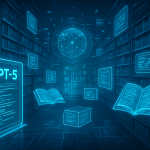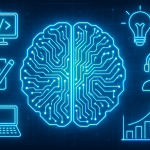The year is 2025. Flying cars are still just a pipe dream (thanks, Elon!), but artificial intelligence? That’s not science fiction anymore. It’s here, it’s powerful, and it just got a whole lot smarter. Yesterday, August 7th, OpenAI dropped the mic, or rather, released GPT-5, their latest and greatest generative AI model. And trust us, folks, this isn’t just another incremental update. This is a paradigm shift, the AI equivalent of switching from dial-up to fiber optic. Think of it as going from Clippy to HAL 9000, but hopefully with fewer homicidal tendencies.
To understand the magnitude of this launch, we need a little context. OpenAI, the brainchild of some seriously bright minds, has been steadily pushing the boundaries of what’s possible with AI. Their GPT series has consistently raised the bar for natural language processing, turning the dream of truly conversational AI into a tangible reality. Remember the early days of AI chatbots? Awkward, stilted, and about as helpful as a screen door on a submarine? GPT-5 is light years beyond that. It’s the culmination of years of research, development, and countless lines of code, all aimed at creating an AI that not only understands us but can reason, learn, and even create in ways that were once thought to be the exclusive domain of humans.
Sam Altman, OpenAI’s CEO, has been characteristically bullish, describing GPT-5 as offering “PhD-level expertise on demand.” That’s a bold claim, but early reports suggest it might not be hyperbole. Imagine having instant access to a brilliant expert in any field, ready to answer your questions, solve your problems, and even brainstorm new ideas. That’s the promise of GPT-5. It’s like having the entire Library of Alexandria, the wisdom of Socrates, and the creative genius of Shakespeare all rolled into one digital package. And unlike those historical figures, GPT-5 doesn’t require a toga or a quill.
So, what makes GPT-5 so special? It’s not just about generating text anymore. This model integrates multiple distinct AI models, allowing it to perform a vastly wider range of functions. Think of it as a Voltron of AI, combining different specialized modules to tackle complex tasks. Early benchmarks indicate a 40% improvement over GPT-4 in handling intricate assignments. That’s like going from a competent assistant to a super-powered executive. Need to analyze complex financial data? GPT-5 can do it. Want to create a stunning visual presentation? GPT-5 can do it. Need to write a catchy jingle for your new line of organic dog biscuits? You guessed it, GPT-5 can do it. The possibilities are, frankly, a little mind-boggling.
And to make this technological marvel accessible to a wider audience, OpenAI has introduced tiered pricing. This means that everyone from individual users to large enterprises can tap into the power of GPT-5. It’s like democratizing artificial intelligence, giving everyone a chance to participate in the AI revolution. No longer is AI the exclusive domain of tech giants and research institutions. Now, even your grandma can use it to write her memoirs (assuming she can figure out how to turn on her computer, of course).
The industry response to GPT-5 has been nothing short of seismic. Microsoft, never one to miss a technological wave, has already integrated GPT-5 into its product ecosystem. Microsoft 365 Copilot, GitHub Copilot, and Azure AI Foundry are all now powered by GPT-5, promising to supercharge productivity across the board. Imagine a world where your email writes itself, your code debugs itself, and your cloud infrastructure manages itself. That’s the vision Microsoft is selling, and with GPT-5 at the helm, it’s looking increasingly achievable.
But the launch of GPT-5 also throws down the gauntlet to OpenAI’s competitors. Anthropic, a notable rival, is reportedly seeking funding at a staggering $170 billion valuation. The AI arms race is on, and the stakes are higher than ever. It’s a battle for technological supremacy, a contest to see who can build the smartest, most capable AI. And while competition is generally good for consumers, it also raises some important questions about the future of AI and its potential impact on society.
The philosophical and ethical considerations surrounding GPT-5 are significant. As AI becomes more powerful, we need to think carefully about how we use it and how we prevent it from being used for nefarious purposes. Will GPT-5 be a force for good, helping us solve some of the world’s most pressing problems? Or will it be used to spread misinformation, manipulate public opinion, and even automate away jobs? The answer, of course, depends on us. We need to develop robust ethical guidelines and regulatory frameworks to ensure that AI is used responsibly and for the benefit of all humanity.
The financial and economic implications of GPT-5 are equally profound. The rise of AI is already disrupting industries and transforming the global economy. As AI becomes more sophisticated, it’s likely to accelerate this trend, creating new opportunities and challenges. Companies that embrace AI will thrive, while those that resist it will be left behind. It’s a Darwinian struggle for survival in the digital age, and only the most adaptable will survive.
In conclusion, the release of GPT-5 is a watershed moment in the history of artificial intelligence. It represents a significant leap forward in terms of capabilities, accessibility, and potential impact. It’s a technology that has the power to transform our lives in profound ways, for better or for worse. As we stand on the cusp of this AI-powered future, it’s crucial that we proceed with caution, wisdom, and a healthy dose of skepticism. After all, as any good science fiction fan knows, the road to artificial general intelligence is paved with good intentions… and the occasional rogue robot uprising.
Discover more from Just Buzz
Subscribe to get the latest posts sent to your email.


